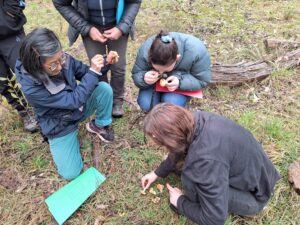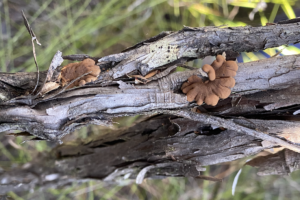The Fungimap Research Grant is a biannual small grant open to citizen scientists and those building the capacity of fungi citizen science in Australia. It helps to cover the cost of citizen scientist research for Australia’s native fungi. The Australasian Mycological Society also have a Research Grant program open to people associated with an Australasian research organisation.
Our next grant round is likely to be in early 2025, subscribe to our eNews or become a Fungimap member to be notified when it is launched.
Fungimap Research Grants are made possible by generous donations from individuals and organisations. We are a registered charity and donations of more than $2 are tax-deductible. Make a donation here.
Current ongoing research grant projects:
- Katrina Syme: Filling the Fungal Gaps in South West Australia, seeking to further document fungal species and describe and publish at least two new taxa from the South West Australia Ecoregion.
- Tijana Petrovic: Diversity of macrofungi in the Waite nature reserves (Adelaide, SA), seeking to investigate fungal genera/species including those that form ECM associations with various native tree species in two different habitats as well as exotic trees in the Waite Arboretum, their distribution, a possible shift in diversity, as well as creating brochures as an educational resource.
Past grant round projects and their reports are listed here:
- Jessica Bamford and Sam Whiting: Analysis of Cortinarius in the Adelaide Hills. Fully sponsored by the Adelaide Hills Science Hub, this was a pilot project of 20 Cortinarius collections and a community workshop with the Adelaide Hills Science Hub and Fungimap. Jess delivered a webinar for the Fungimap community in November 2023 sharing their results, and you can read the full report here.

Finding Cortinarius in the field at community workshop

-
- Ema Corro and MYCOmmunity: Using LAMP to hunt for the critically endangered Tea Tree Fingers, aimed to develop a LAMP test to detect Tea Tree Fingers DNA and/or RNA, search for new populations, document presence/absence results, and train citizen scientists. You can read the most recent update report here.
- Ema Corro and MYCOmmunity: Using LAMP to hunt for the critically endangered Tea Tree Fingers, aimed to develop a LAMP test to detect Tea Tree Fingers DNA and/or RNA, search for new populations, document presence/absence results, and train citizen scientists. You can read the most recent update report here.



